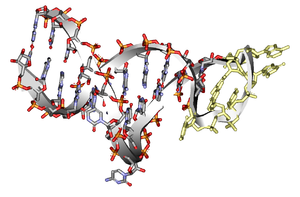Iron Response Element

The Iron Response Element (IRE, engl. About responsive to iron element ) is a structure in a mRNA , a regulation emanating from this RNA protein synthesis (translation) in response to the availability of iron allowed in the cell. As a result, IREs play a central role in controlling gene expression of iron metabolism in animals . In contrast, they are not found in plants or mushrooms .
structure
Iron Response elements are highly conserved between different genes and organisms, i.e. their nucleotide sequences and, above all, the spatial structure occupied by the element are very similar in all IREs. They form a short hairpin structure . This consists of a double-stranded stem that is variable in sequence and contains one or more unpaired bases in the middle and can thus form a characteristic kink. A six base pair loop with the consensus sequence 5'-CAGUGN-3 'is attached to the upper part of the stem, which comprises five paired bases .
regulation
In the event of iron deficiency, the IRE serves as a binding site for iron response proteins (IRPs, also IRE binding proteins , IRE-BP ). This bond leads to different effects depending on the position:
- The binding of IRPs to a single IRE in the 5 ' UTR (the untranslated region in front of the protein coding sequence) of an mRNA leads to the repression of the translation, probably by preventing the binding of the ribosomes to the RNA. This reduces the amount of the corresponding protein in the cell. An example of a protein regulated in this way is the iron storage protein ferritin .
- The binding of IRPs to several IREs in the 3'UTR (the untranslated region behind the protein-coding sequence) of an mRNA leads to their stabilization, probably by preventing attack by RNases . As a result, the mRNA can be translated longer and the concentration of the corresponding protein in the cell increases. An example of a protein regulated in this way is the transferrin receptor , which allows increased iron uptake into the cell by binding the iron transport protein transferrin .
swell
- MW Hentze, Kuhn LC: Molecular control of vertebrate iron metabolism: mRNA-based regulatory circuits operated by iron, nitric oxide, and oxidative stress . In: Proc Natl Acad Sci USA . 93, pp. 8175-8182. doi : 10.1073 / pnas.93.16.8175 . PMID 8710843 .
